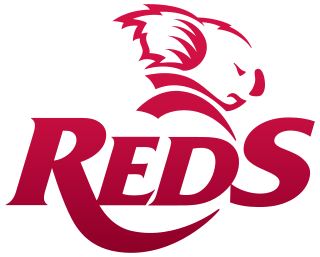
The Queensland Reds is the rugby union team for the Australian state of Queensland that competes in the Southern Hemisphere's Super Rugby competition. Prior to 1996, they were a representative team selected from the rugby union club competitions in Queensland. With the introduction of the professional Super 12 competition they moved to a model where players are contracted to the Reds through the Queensland Rugby Union rather than selected on the basis of club form.

Lang Park, nicknamed "The Cauldron", also known as Brisbane Stadium and by the sponsored name Suncorp Stadium, is a multi-purpose stadium in Brisbane, Queensland, Australia, located in the suburb of Milton. The current facility comprises a three-tiered rectangular sporting stadium with a capacity of 52,500 people. The traditional home of rugby league in Brisbane, the modern stadium is also now used for rugby union and soccer and has a rectangular playing field of 136 by 82 metres. The stadium's major tenants are the Brisbane Broncos, the Dolphins (NRL), the Queensland Reds and the Queensland Maroons.

Newcastle International Sports Centre, known as McDonald Jones Stadium for sponsorship reasons, is a multi-purpose sports stadium located in Newcastle, Australia. The ground is home to the Newcastle Knights and Newcastle Jets FC (A-League). It is owned by the Government of New South Wales and is administered by Venues NSW. Due to past sponsorship deals, the ground has been previously known as Marathon Stadium, EnergyAustralia Stadium, Ausgrid Stadium and Hunter Stadium. Newcastle International Sports Centre is also known as Newcastle Stadium when in use during AFC competitions due to conflicting sponsorship reasons.

Carrara Stadium is a stadium on the Gold Coast in Queensland, Australia, located in the suburb of Carrara.

The Brisbane Cricket Ground, commonly known as the Gabba, is a major sports stadium in Brisbane, the capital of Queensland, Australia. The nickname Gabba derives from the suburb of Woolloongabba, in which it is located. Over the years, the Gabba has hosted athletics, Australian rules football, baseball, concerts, cricket, cycling, rugby league, rugby union, Association football and pony and greyhound racing. At present, it serves as the home ground for the Queensland Bulls in domestic cricket, the Brisbane Heat of the Big Bash League and Women's Big Bash League, and the Brisbane Lions of the Australian Football League. It is also the secondary home of the Brisbane Broncos of the National Rugby League. The stadium will receive an upgrade for the 2032 Summer Olympics and Paralympics.

The Queensland Sport and Athletics Centre is a multi-purpose sports facility in Nathan, Queensland, located 10 kilometres south-east of the Brisbane CBD. Its main stadium – formerly known as QEII Stadium, and later ANZ Stadium under a naming rights agreement with ANZ – accommodates 48,500 spectators, while its smaller State Athletics Facility accommodates 2,100 spectators. Both stadiums feature Rekortan running tracks and natural grass fields. The Queensland Academy of Sport, Queensland State Netball Centre, and a complex of beach volleyball courts are also housed at the facility. QSAC is owned by the Queensland Government, and its main stadium and State Athletics Facility are operated through its agency, Stadiums Queensland.
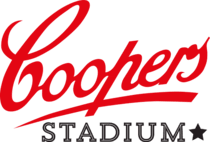
Hindmarsh Stadium is a multi-purpose stadium in Hindmarsh, an inner western suburb of Adelaide, South Australia. It is the home of the Australian A-League team, Adelaide United.

The Willows Sports Complex was a grass football stadium situated in Townsville, Queensland, Australia. It was used predominantly as a rugby league ground as the home ground of the North Queensland Cowboys National Rugby League club. The ground was also used for rugby union and soccer. From 2009 to 2011, A-League football club North Queensland Fury called it home.
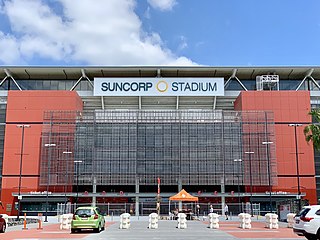
Sport is a significant aspect of the Brisbane lifestyle. Activities range from the occasional international event, annual competitions, competitive leagues and individual recreational pursuits.

Browne Park is a rectangular football stadium located in the Rockhampton suburb of Wandal, Queensland, Australia. The venue has been the home of rugby football in Central Queensland since 1890 and today also hosts rugby union and soccer matches. It hosted a match of the 2008 Rugby League World Cup. The ground was named Browne Park in 1958 as a posthumous honour to long serving president of Rockhampton Rugby League, Jack Browne who died in office.

Dolphin Stadium is a sports stadium in the suburb of Kippa-Ring in the City of Moreton Bay, north of the adjoining Brisbane metropolitan city, Queensland, Australia. Formerly known as Moreton Daily Stadium under a previous naming rights agreement, the stadium serves as the home ground for the Redcliffe Dolphins rugby league club in the Queensland Cup, and NRL club, the Dolphins.
Clive Berghofer Stadium is a stadium in Toowoomba, Queensland, Australia. Situated on Mary Street on the eastern fringes of Toowoomba CBD adjacent to Queens Park and Toowoomba East State School. The ticket counters and entrance are on Arthur Street behind the grandstand.
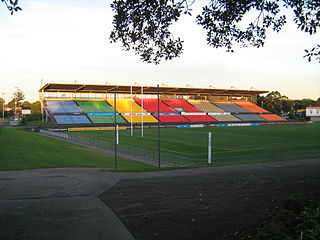
Concord Oval, is a rugby football stadium in the inner-west Sydney suburb of Concord, Australia. The stadium is able to hold 5,000 people as of November 2022, down from 20,000 when the Concord Oval was opened in 1985. As of 2022, it is used mostly for rugby union matches and hosted eight matches during the 1987 Rugby World Cup. It is also a venue for soccer matches and local rugby league matches.
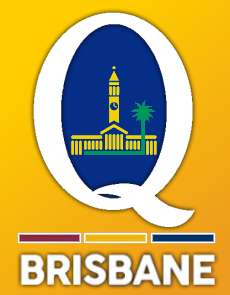
Brisbane City is an Australian rugby union football team based in Brisbane that competed in the National Rugby Championship (NRC). The team is one of two Queensland sides in the competition, the other being Queensland Country. Brisbane City is organised and managed by the Queensland Rugby Union (QRU), with the coaching and training programs utilised by the Queensland Reds being extended to players joining the team from the Reds and Queensland Premier Rugby teams.
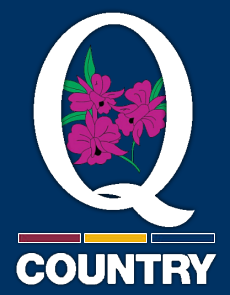
Queensland Country is an Australian rugby union football team that competed in the National Rugby Championship (NRC). The team is one of two Queensland sides in the competition, the other being Brisbane City. Queensland Country is organised and managed by the Queensland Rugby Union (QRU), with the coaching and training programs used at the Queensland Reds extended to players joining the team from the Reds, Premier and Country rugby teams.

Rugby union in Queensland has traditionally been one of the most popular professional and recreational team sports in the state. Rugby union was introduced in the British colony's capital Brisbane in 1876. Initially it struggled to gain a foothold due to the popularity of Australian rules there until it got its break in 1882 with the first inter-colonial matches against New South Wales, and the formation of the Northern Rugby Union. Between 1885 and 1887 it became the dominant code after the leading schools association decided to play it exclusively and after 1890 spread virtually unopposed throughout the colony.

Penrith Stadium is a rugby league and association football stadium located in Penrith, New South Wales, Australia.

Springfield Central Stadium is an Australian rules football venue located in Springfield, a suburb of Ipswich, approximately 30 km south-west of Brisbane.



















